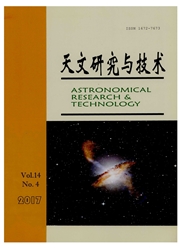

 中文摘要:
中文摘要:
在太阳磁场观测中,要得到几高斯的灵敏度,通常需要经过多帧短曝光图像叠加获取高信噪比的图像。由于大气抖动和风的影响使得观测图像存在线性位移,因此需要采用图像配准技术进行位移叠加。通过比较相位相关和互相关算法的图像配准算法,对模拟图像和实测图像进行了处理,采用了差分图像的平均值、均方差、配准图像的最大相关值、叠加图像的熵和磁场图像的能量5个统计量对处理结果进行评价,认为相位相关算法对噪声更为敏感,而互相关算法更适合太阳磁场的位移叠加处理。
 英文摘要:
英文摘要:
In observing solar magnetic field, which can be as weak as a few Gausses, multiple short- exposure images usually need to be stacked for obtaining images of high signal-to-noise ratios (SNR). In short-exposure images there are linear-coordinate displacements due to influence of atmospheric turbulences and wind. Direct stacking of these can smooth away features of a few Gausses. Image correction and stacking techniques thus need to applied. We compare and analyze two algorithms for the purpose, the phase correlation method and phase cross-correlation method. We use the methods to process simulated data and eight sets of actual images of solar magnetic fields. The processing results are evaluated through certain parameters, including the average and standard deviation of error images, the correlation value between reference and shifted images, the entropies of stacked images, and the image-energy values of the magnetic-field images. The results show that the cross-correlation method is less sensitive to noise and faster. It implies that the cross-correlation method is more suitable for correcting and stacking real-time solar magnetic-field images.
 同期刊论文项目
同期刊论文项目
 同项目期刊论文
同项目期刊论文
 期刊信息
期刊信息
